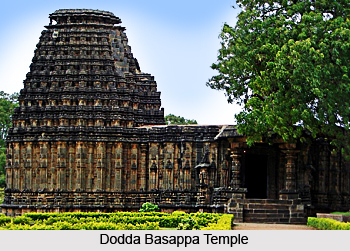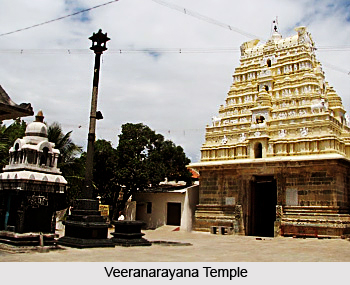 Pilgrimage tourism in the Gadag district in Karnataka provides one with an in depth knowledge about the intricacies of Kalyani Chalukya art. Most temples here have been constructed during the reign of the Kalyani Chalukya and Hoysala dynasties, and are splendid specimens of the architectural prowess of these kingdoms. A few of the most prominenet ones are discussed.
Pilgrimage tourism in the Gadag district in Karnataka provides one with an in depth knowledge about the intricacies of Kalyani Chalukya art. Most temples here have been constructed during the reign of the Kalyani Chalukya and Hoysala dynasties, and are splendid specimens of the architectural prowess of these kingdoms. A few of the most prominenet ones are discussed.
It is believed that the Veeranarayana temple was built by the Hoysala King Bittideva in 117 A.D. after taking religious vows from Shri Ramanujacharya. This is one among the Pancha Narayana temples he built. Shri Veeranarayana temple is a beautiful mixture of Chalukya, Hoysala and Vijayanagara sculptures. The garbhagriha and the top tower of the temple are models of Chalukya sculpture; Garuda Gamba and Rangamantap are in the manner of Hoysala sculpture. The main entrance gate of the temple is of Vijayangara art.
The Garuda Gamba is seen as soon as one steps into the entrance which faces east. Behind the Garuda Gamba lies the Okali Well and near it are the Shrivaishnava triprundras. Facing it stands Garuda statue in Namaskara position. Inside the Veeranarayana temple has many pillars with artistically carved pictures. Then come the Madhyaranga, then Garbhagriha in Garbhagudi. The Shri Veeranarayana statue carved in dark blue shaded stone is a major attraction. Decorated with Kireeta, Karnakundala, Shankha, Chakra, Gadha, and Padma and in the robe of Veeragachche, Veeranarayana stands protecting his Bhaktas with Abhayahasta. In his broad bosom is Goddess Laxmi, at the pedestrial aureole the Dashawathara and at both sides stand Laxmi and Garuda. In the courtyard of this temple, there are other small temples of gods and goddesses like Laxmi-Narasimha temple, Sarpeshwara temple and so on. Gadag District is an important station in the Hubli-Sholapur line. It is also well connected by buses from Hubli-Dharwad and Hospet.
 Famous for its grapes and guavas, Dambala lies 20 Kms from Gadag. It boasts of many fine temples - the best being the Dodda Basappa temple. Dedicated to Lord Shiva, the Dodda Basappa temple belongs to the Kalyani Chalukya period. It is renowned for its multigonal stellar shape. It contains one of the most beautifully designed door steps that can be seen in any temple in western India. This doorstep is exquisitely engraved with festoons, rosettes and small figures. Apart from this the temple also has marvellously carved pillars and walls. Also at Damabla is situated a Buddhist shrine dedicated to the Goddess Taradevi. The nearest railway station is Gadag railway station. Dambal is also well connected by buses from Gadag and Mundargi.
Famous for its grapes and guavas, Dambala lies 20 Kms from Gadag. It boasts of many fine temples - the best being the Dodda Basappa temple. Dedicated to Lord Shiva, the Dodda Basappa temple belongs to the Kalyani Chalukya period. It is renowned for its multigonal stellar shape. It contains one of the most beautifully designed door steps that can be seen in any temple in western India. This doorstep is exquisitely engraved with festoons, rosettes and small figures. Apart from this the temple also has marvellously carved pillars and walls. Also at Damabla is situated a Buddhist shrine dedicated to the Goddess Taradevi. The nearest railway station is Gadag railway station. Dambal is also well connected by buses from Gadag and Mundargi.
Once an important centre for religious training today Lakkundi has several temples resembling the Kalyani Chalukya style. Though many were damaged during the invasion, quite a few have since been rebuilt. The Kashivishwashwara temple is one of them. This beautiful temple is exquisitely decorated with carvings, scroll work, stone screens etc. A double temple also houses a Surya (Sun) temple. The Sun temple is dedicated to Lord Surya Narayana and contains a throne for the image of the God. The seven horses of the Sun god are engraved on the stone. Apart from these temples there is also a Jain temple at Lakkundi that has an image of Lord Mahavira seated on a lion throne. It is called Bhahma Jinalaya and is said to have been built by the noble lady, Atttimabbe. There is also a museum run by the Archaeological Survey of India with a fine collection of art works. The nearest railway station is Gadag from where buses are easily available for reaching Lakkundi.
These are the various places of pilgrimage tourism in Gadag district that bear testimony to the architectural prowess of the Kalyani Chalukya and Hoysala dynasties that built them.



















